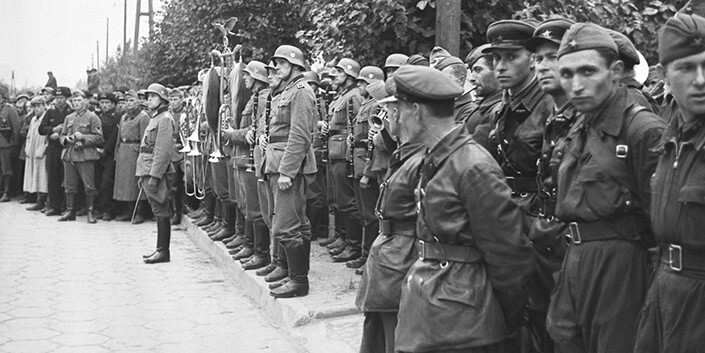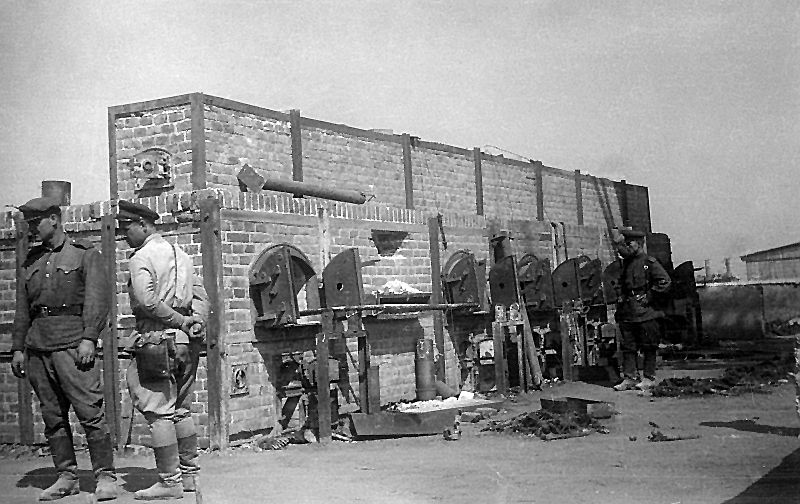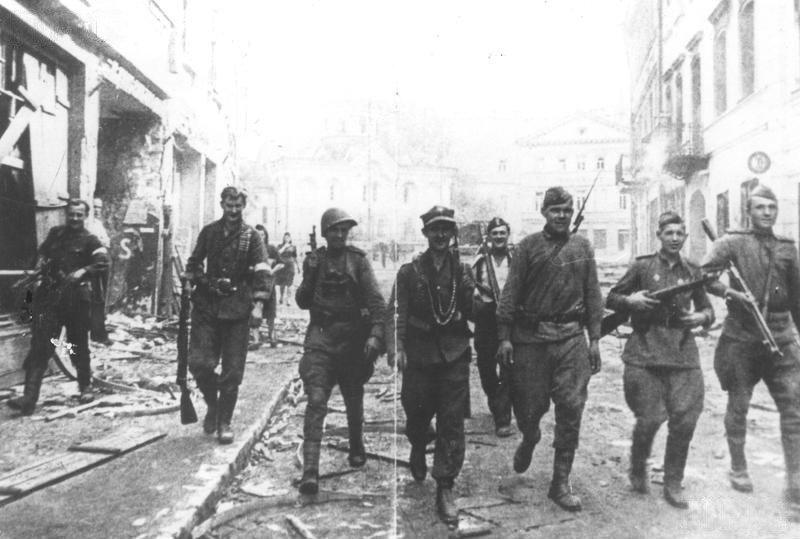Majdanek: the German concentration camp reused by the USSR against anti-Nazi Poles
This week many media have talked about the 75th anniversary of the arrival of the Red Army in Auschwitz. However, there is another much less known German concentration camp.
The pact between Germans and Soviets to divide Poland
As you know, on August 23, 1939, Hitler's Germany and Stalin's USSR signed the so-called Ribbentrop-Molotov Pact, which included secret clauses (which were not discovered until 1945) for which both powers divided Poland, Finland, Lithuania, Latvia and Estonia. On September 1 of that year Germany invaded Poland, and on September 17 the USSR joined the invasion, occupying the eastern fringe of the country as previously agreed with Germany. In the following months, until the start of the German invasion of the USSR on June 22, 1941, Germans and Soviets actively collaborated, including exchanging prisoners and holding joint meetings between the Gestapo and its communist counterpart, the NKVD.

The creation of the Majdanek concentration camp by order of Himmler
After the German invasion of the USSR, the head of the German SS, Heinrich Himmler, ordered the construction of a concentration camp near the city of Lublin, in occupied Poland. Officially named Konzentrationslager Lublin, the field was built next to the suburb of Majdan Tatarski, so the locals nicknamed it Majdanek (the little Majdan). Built by Jewish and Soviet prisoners in conditions of slavery, in September 1942 this concentration camp became an extermination camp, beginning to kill prisoners by means of Zyklon B gas in application of the "Final Solution" policy approved by the Third Reich against the Jews. 130,000 men, women and children were sent to that camp, mostly Jews and non-Jewish Poles (remember that Majdanek was one of the destinations of 116,000 Zamość Poles deported by the Germans), followed by smaller groups of prisoners of other nationalities. In the spring of 1943 the Germans began sending Majdanek to a part of the Jews from the Warsaw and Białystok ghettos. According to the Majdanek State Museum, 80,000 people were killed there, 60,000 of them Jews.

Stalin's plans for post-war Poland
Majdanek has gone down in history not only for the crimes that the Germans committed there, but also because it was the first extermination camp discovered by the Allies. The Red Army arrived on the compound on July 22, 1944. That same year Majdanek also became the first stage of a commission to clarify crimes against humanity committed by the Germans in the death camps. However, in the summer of 1944 it would be the scene of a dishonorable and little known event outside Poland. At that time, Stalin was already thinking about the postwar period and his plans clashed with the existence of a great Polish resistance that for the most part was not communist. The Polish resistance began to form on September 27, 1939, in full German-Soviet invasion, with the creation of Służba Zwycięstwu Polski (Victory Service of Poland). In the following years, an authentic Polish underground State was formed, loyal to the Government of Poland in exile, based in London and whose purpose was to end the war with the Poland's recovery as a free and democratic nation.

The Polish non-communist resistance: the AK, the BCh and the NSZ
The largest resistance organization against the Germans of World War II was created in Poland: the Armia Krajowa (AK, Home Army), formed on February 14, 1942 from the merger of other clandestine organizations. The AK had about 400,000 members, most of them Polish Catholics. Loyal to the Polish Government in exile, it directed its efforts to fight the Germans, even agreeing to collaborate with the Soviets - for example, in the liberation of Vilnius - despite the bad relations they had with them. In addition to the AK, the Bataliony Chłopskie (BCh, Peasant Battalions), similar to the Polish agrarian right, had about 160,000 members. Partially integrated into the AK, the BCh were also loyal to the Polish Government in exile and focused their work on fighting the Germans. Likewise, the Narodowe Siły Zbrojne (NSZ, National Armed Forces), related to the nationalist right, had about 70,000 members, many of whom refused to follow the orders of the Polish Government in exile, fighting equally against Germans and Soviets .
The Polish communist resistance: from the Czerwoną Milicję to Armia Ludowa
As in other countries occupied by the Germans, the Polish communist resistance did not form until the German invasion of the USSR. In 1941 the meager Czerwoną Milicję (Red Militia) was formed, barely active outside of Warsaw, and in March 1942 the Gwardia Ludowa (People's Guard) was created, which in 1944 gave rise to the Armia Ludowa (People's Army). Both organizations were loyal to Moscow and their troops were always far inferior to those of the other resistance groups (reaching about 40,000 members at their best), partly because the vast majority of Poles did not sympathize with communism - remember that the Bolsheviks had invaded Poland in 1920, being defeated in the Battle of Warsaw-, and partly also because of Stalin: remember the purge of 1937 and 1938 against the Polish minority in the USSR ended with the murder of between 50,000 and 60,000 people, many of them communists. So Stalin had a problem: he wanted to establish a communist dictatorship in post-war Poland, but Polish non-communist resistance was much stronger than those faithful to Moscow.

Stalin ordered to liquidate the non-communist resistance without waiting for the German defeat
Stalin's decision to solve that problem was to issue an order on July 13, 1944 to liquidate the Polish resistance that did not follow Moscow's orders, and he did so without even waiting for the Germans to have been expelled from Poland. As I mentioned here, in July 1944, after their decisive contribution to the liberation of the city of Vilnius, thousands of AK fighters were persecuted and detained by the Soviet NKVD. Similar events occurred in Lviv and Lublin by those dates. It was a flagrant betrayal by the Soviets to Polish resistance, a betrayal that British Information Minister Brendan Bracken ordered to hide. Recall that on August 1, 1944 the AK began the Warsaw Uprising against the Germans. Many AK fighters who could have contributed to that operation had previously been arrested by the Soviets.
Majdanek's reactivation by the Soviets to imprison the Polish resistance
On July 23, the Soviets took Lublin and turned the city into the new capital of communist Poland, with the creation of the so-called Polish National Liberation Committee, a puppet government of Moscow. Repression soon began: in Poland’s Holocaust (2007), Tadeusz Piotrowski points out that between July 1944 and June 1945, more than 50,000 Poles were arrested in the Lublin area alone. In mid-August 1944, the former German concentration camp at Majdanek was partially reactivated by the NKVD, previously evicted from former prisoners who had survived the captivity imposed by the Germans. The NKVD used the camp to recruit members of the Polish resistance, mainly members of the AK and the BCh, but also members of the NSZ and the Wolność and Niezawisłość (WiN, anti-communist resistance organization formed by former members of the AK). Paradoxically, the place chosen by the Soviets was the so-called Field III, which had previously housed Polish deportees from the Zamość region. Today it is known that thousands of members of the Polish resistance were executed by the Soviets, and tens of thousands were deported to Siberia, treated as enemies, spies and traitors, despite having been fighting for years against the Germans.

At present, the actual number of Polish resistance prisoners who passed through Majdanek Field III controlled by the NKVD, which was used as a transit camp for Polish prisoners who were later deported to other camps in Russia, is still unknown.refused to join the Red Army as a treason to their Homeland. On August 23, 1944, a group of 250 Polish prisoners from Ryazan also arrived in Majdanek, who were later sent to gulags in Diagilew, Susłongierz, Griazowiec, Czerepowiec and Skopin.
A direct testimony of the subhuman conditions of the NKVD camp
The NKVD continued to use the camp until 1945: while the Red Army entered Auschwitz, the Soviets already held Poles imprisoned in Majdanek in subhuman conditions, as evidenced by a document found in Field III quotd by the Majdanek State Museum, which contains a list with names of 84 officers and 52 noncommissioned officers of the Polish resistance who were there, along with a brief note that says: "We are treated as prisoners of war. The food is terrible – many men suffer from stomach problems. We are denied contacts with our families. No food or clothing parcels from the outside are allowed. The most pressing problem – vaccination against dysentery and typhus. Food is served in primitive conditions, no spoons, bowls, etc. Men are looking for some dishes in the garbage. We have not been informed about the reason of our internment or what is to become of us."
These men were heroes who had fought courageously against the Nazis, to finally be treated as traitors, bandits and enemies by the Soviets. I dedicate this post to all the victims of the Majdanek camp, including those Polish patriots who are now practically ignored beyond their Nation.
Cześć i chwała bohaterom!
Honor and glory to the heroes!

Bibliography:
- Państwowe Muzeum na Majdanku. Official website of the Majdanek State Museum, in Polish and English.
- Auschwitz and the so-called Soviet liberation of Poland, by Norman Davies.
- The Doomed Soldiers. Polish Underground Soldiers 1944-1963 - The Untold Story. A large documentary fund on the members of the Polish resistance who fought against the Germans and who since 1944 continued their fight against the new Soviet occupiers.
- Służba zdrowia 27. Wołyńskiej Dywizji Piechoty Armii Krajowej, by Zdzisław Jezierski.
- Poland's Holocaust, by Tadeusz Piotrowski (2007).
- Ewidencja zgonów i śmiertelność więźniów KL Lublin, by Tomasz Kranz (2005).
---
Main photo: Adam Jones, Ph.D. / Wikimedia.
|
Don't miss the news and content that interest you. Receive the free daily newsletter in your email: Click here to subscribe |
- Most read
- The 'hole' without civil flights around Paris during the opening of the Olympic Games
- Spain vetoes the Russian frigate 'Shtandart', which intended to reach Vigo, in all its ports
- The interior of the Statue of Liberty torch and the sabotage that canceled its visits
- The ten oldest national flags in the world that are still in use today
- The BNG boasts of the support of a terrorist group and a dictatorship at a public event
- The Russian intelligence document that sparked a hoax about French troops
- A virtual tour of ancient Rome in full color, just as it was in its heyday

 ES
ES





Comentarios:
Richard Varga
Thank you for this concise overview of a complex and too little mentioned piece of central Europen history, almost unknown beyond Central Europe it affects more than just the history of Polish resistance to both fascism & communism, ie Baltic states, Ukraine.
2:07 | 5/03/20
Opina sobre esta entrada: